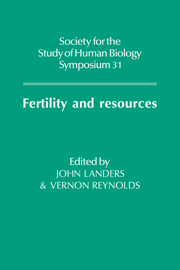Book contents
- Frontmatter
- Contents
- List of contributors
- 1 Introduction
- 2 Environmental and social determinants of fecundity in primates
- 3 Biological aspects of fertility among Third World populations
- 4 A preliminary report on fertility and socio-economic changes in two Papua New Guinea communities
- 5 The cultural context of fertility transition in immigrant Mennonites
- 6 Inter-relationships between consanguinity, religion and fertility in Karnataka, South India
- 7 Resources and the fertility transition in the countryside of England and Wales
- 8 Fertility decline and birth spacing among London Quakers
- 9 Population growth, innovation and resource exploitation
- 10 Fertility decline in developing countries: the roles of economic modernization, culture and Government interventions
- 11 Understanding recent fertility trends in the Third World
- 12 Monogamy, landed property and demographic regimes in pre-industrial Europe: regional contrasts and temporal stabilities
- Index
5 - The cultural context of fertility transition in immigrant Mennonites
Published online by Cambridge University Press: 13 March 2010
- Frontmatter
- Contents
- List of contributors
- 1 Introduction
- 2 Environmental and social determinants of fecundity in primates
- 3 Biological aspects of fertility among Third World populations
- 4 A preliminary report on fertility and socio-economic changes in two Papua New Guinea communities
- 5 The cultural context of fertility transition in immigrant Mennonites
- 6 Inter-relationships between consanguinity, religion and fertility in Karnataka, South India
- 7 Resources and the fertility transition in the countryside of England and Wales
- 8 Fertility decline and birth spacing among London Quakers
- 9 Population growth, innovation and resource exploitation
- 10 Fertility decline in developing countries: the roles of economic modernization, culture and Government interventions
- 11 Understanding recent fertility trends in the Third World
- 12 Monogamy, landed property and demographic regimes in pre-industrial Europe: regional contrasts and temporal stabilities
- Index
Summary
Introduction
In the 1870s, Mennonites from the village of Alexanderwohl in the Ukraine Molotschna Colony immigrated to the United States and settled in choice farming areas around Goessel and Meridian, Kansas, and Henderson, Nebraska (McQuillan, 1978; Crawford & Rogers, 1982; Stevenson et al., 1989; see Figure 5.1). They arrived with large families to a country already in the midst of fertility decline (Vinovskis, 1981), and within one generation they also were reducing family size (Stevenson et al., 1989). The recency of this fertility transition provides an opportunity to assess the relative importance of education, occupational opportunities outside the home, and the labour value of children in stimulating the reproductive decline for the Kansas and Nebraska Mennonites. This analysis is based on Caldwell's (1982) wealth flows model as modified by Handwerker (1986a, b, c).
Foreign colonists who had settled in Russia since 1763 were exempt from military and civil service ‘in perpetuity’ (Rempel, 1974). However, reforms in the 1860s resulted in the cancellation of this exemption and institution of compulsory military service. The most politically conservative portion of the Mennonite population (eventually one-third) began to emigrate to the United States and Canada in the 1870s. Many selected choice farmland in Kansas and Nebraska with the aid of railroad agents, and by the 1880s Mennonites were some of the most successful farmers, experiencing relatively few foreclosures during the severe droughts of the 1890s (McQuillan, 1978).
The Mennonite group which immigrated was also the most religiously conservative of the Molotschna Colony (Rempel, 1974).
- Type
- Chapter
- Information
- Fertility and Resources , pp. 47 - 61Publisher: Cambridge University PressPrint publication year: 1990

